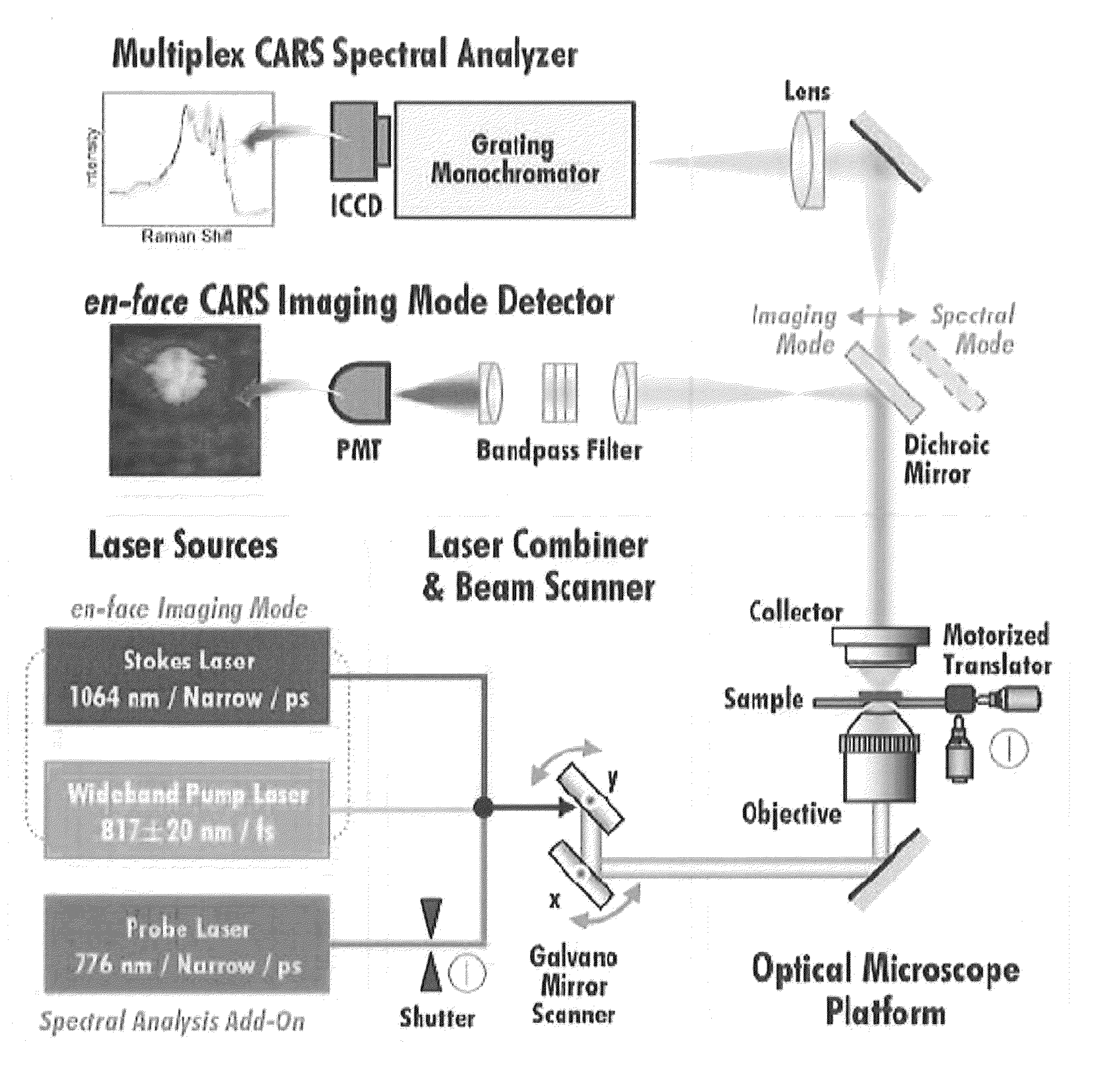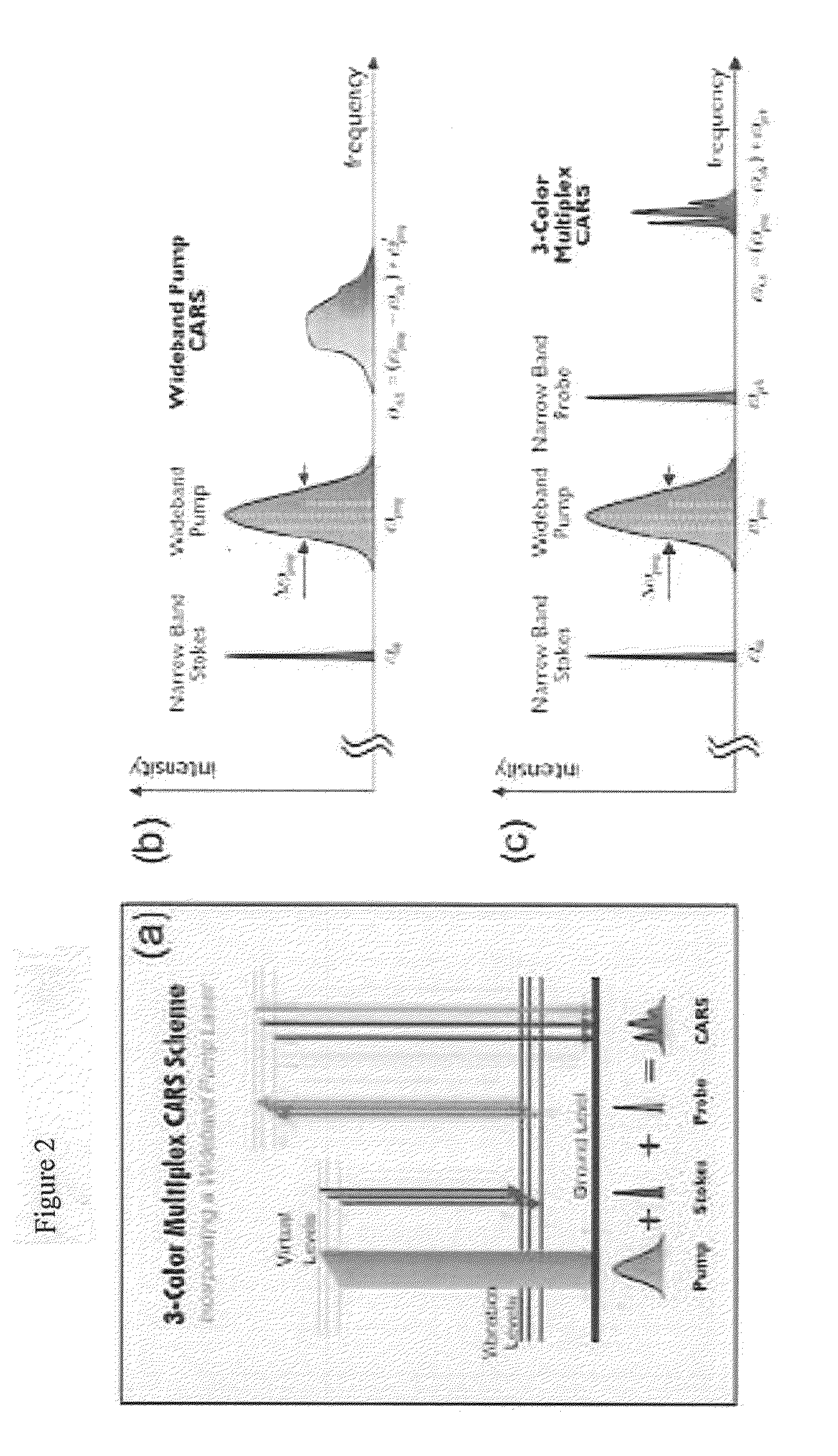System for diagnosing pathological change of lipid in blood vessels using non-linear optical microscopy
a non-linear optical microscopy and pathological technology, applied in the field of diagnostics, can solve problems such as difficult to read pathological, difficult to indicate plaque vulnerability, and damage to tissu
- Summary
- Abstract
- Description
- Claims
- Application Information
AI Technical Summary
Benefits of technology
Problems solved by technology
Method used
Image
Examples
experimental example 1
En Face CARS 3D Imaging of Atherosclerotic Lesion
[0078]En face chemical imaging of mouse and human atherosclerotic plaques was performed using the CARS microscope of Example 1. After whole aortas were harvested from atherosclerotic ApoE− / − mice (n=28), the lesser curvature of the aortic arch and the carotid artery was longitudinally incised and imaged by CARS, without the use of fixatives.
[0079]FIG. 3 shows the 3D reconstructed CARS image slice, representing atherosclerotic plaques ranging from the lumen side to the deep intima. In the CARS image, bright spots show a high concentration of lipids with CH vibrations characteristic of 2700 to 3050 cm−1, demonstrating typical 3D microscopic traits of atherosclerotic lipids depending on the depth of lesions. In the superficial layers (5 to 10 μm in depth from the lumen), foam cells containing intracellular lipid droplets were clearly imaged, whereas lipid crystals were observed usually in the deep intima region (>25 μm in depth), without...
experimental example 2
Assessment of Atherosclerosis Progression by CARS Imaging
[0082]To assess the progression of atherosclerosis using the CARS imaging platform of Example 1, various levels of atherosclerotic plaques were obtained from ApoE− / − mice (n=28) fed with a high-fat diet for 2 to 20 weeks. As a control, ApoE− / − mice fed with a normal chow diet were assessed at the same time points. Every week, serial en face CARS imaging was performed in mouse aortas. The progression of atherosclerosis was analyzed using CARS images taken for the vertical infiltration of lipids across the aortic wall and the morphological change of lipid structures.
[0083]In the 2-week-old atherosclerosis mouse models, few of the imaged lipid droplets were bound to the extracellular matrix (ECM) (FIG. 6a). In the 4-week-old atherosclerosis mouse models, lipid droplets were observed only in the superficial intima (b). At 6 weeks, the number of lipid droplets was significantly increased relative to the number present at 2 weeks (F...
experimental example 3
Identification of Characteristics of Atherosclerotic Plaques by CARS
[0084]Using 3D CARS imaging, lipid distribution was quantified in three main stages (initial, intermediate and advanced stages: FIG. 7). The progression of atherosclerosis was analyzed in terms of the volume of lipid segments (calculated as 2D coverage in z-stack) and the size of the lipid structure.
[0085]The progression of atherosclerosis was analyzed by quantifying accumulated lipids at 3 stages depending on the period of high-fat diet consumption. During the initial stage (weeks 2-6, FIG. 7A i-iv), only a small amount of lipids is clearly represented in a small size. In the intermediate stage (weeks 8-12, FIG. 7b: i-iv), lipid deposits moved deep in the z-stack. Interestingly, their size was increased in the deep intima to form plate-shaped liquid crystals. In the advanced stage (week 16, FIG. 7c: i-iv), the lipids increased in both coverage and size. Atherosclerotic lipids penetrated to the depth of 30 μm, and e...
PUM
 Login to View More
Login to View More Abstract
Description
Claims
Application Information
 Login to View More
Login to View More - R&D
- Intellectual Property
- Life Sciences
- Materials
- Tech Scout
- Unparalleled Data Quality
- Higher Quality Content
- 60% Fewer Hallucinations
Browse by: Latest US Patents, China's latest patents, Technical Efficacy Thesaurus, Application Domain, Technology Topic, Popular Technical Reports.
© 2025 PatSnap. All rights reserved.Legal|Privacy policy|Modern Slavery Act Transparency Statement|Sitemap|About US| Contact US: help@patsnap.com



